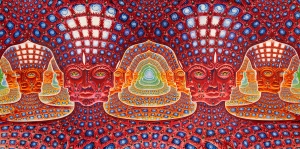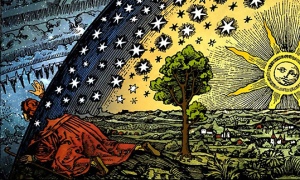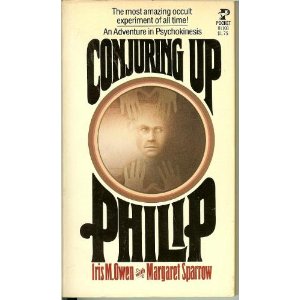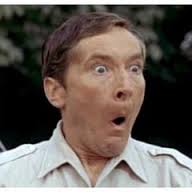The question of the ‘reality’ or otherwise of aliens/elves/spirit beings seems to be a perennial one. At two of my recent lectures, to The Birmingham Psychedelic Society and this month at the Nova Stella moot in London, this was a subject of concern. Aficionados of N,N-DMT, ayahuasca and some other psychedelics (notably high doses of psilocybin) also get to wrestle with this problem. What are the ‘spirits’ that we may encounter when in these altered states?
Perhaps one of the greatest modern commentators on the Western encounter with the entheogenic spirit realm is Terence McKenna, he famously and carefully engineered our appreciation of the entities from DMT space. He developed a highly open-ended mythology that permitted multiple interpretations of his nevertheless emphatically held ideas (the importance of psychedelics in the evolution of humans, the existence of intelligence in the DMT experience, and of a world heading towards an apocalyptic omega point). McKenna remains, in much of his writing and lectures, radically uncertain (or perhaps unwilling) to advance a simple single answer to the question ‘what are these DMT spirits really?’.

DMT heads
Earlier, in the 20th century, Aleister Crowley also addresses the question of the ‘reality’ of entities such as gods, angels, spirits and demons. He counsels the student of magic to be simultaneously respectful of the phenomena and suspicious of its ultimate origin and meaning. And while Crowley, like McKenna, got swept up with an apocalyptic narrative (that of being The Beast 666), much of AC’s work espouses a significant degree of indeterminacy when it comes to the ‘reality’ of these things.
Crowley writes in Magick in Theory and Practice:
“In this book it is spoken of the Sephiroth and the Paths; of Spirits and Conjurations; of Gods, Spheres, Planes, and many other things which may or may not exist. It is immaterial whether these exist or not. By doing certain things certain results will follow; students are most earnestly warned against attributing objective reality or philosophic validity to any of them.”
Psychedelic chemist and counter-cultural hero Casey Hardison, in conversation with Andy Roberts, considers this issue too. In an interview in the forthcoming book by Roberts, Acid Drops (out later this year through Psychedelic Press UK), Casey is asked for his views on the objective reality of these entities. In a characteristically brilliant answer Hardison opines thus:
Andy Roberts: Some people have claimed that during a psychedelic experience they have had contact with/been contacted by what might be termed intelligences or entities. Have you had any such experiences? If so can you give an example?
Casey Hardison: I have no certainty this has ever happened to me. I have, however, made shit up to this effect. I tend to think that the molecules themselves are entities. And, they have given me great insight into the vastness of my intelligence. Sure, I’ve seen the typical machine elves laughing at me and thought ayahuasca was an alien being that resides in my brainstem but I was high at the time.
AR: Do you think these experiences represent objective/real experiences involving entities external to the mind/body, whether their origin is earthly, extra-terrestrial, inter-dimensional, aspects of our mind/psyche or a mixture of any of these and more?
CH: No. I think that these experiences are personifications of the DNA instincts innate to us. They appear to be generated and sensed by our own brains. Jung would call them manifestations of the archetypes. Plato had his perfect forms. I tend to keep it simple and not tool off about possible alien intelligences. In short, I do not know. If there are aliens, I can’t wait to try their drugs.
DMT and related tryptamines may flick a neurochemical switch in our heads that induces a sense of ‘the real’, but that is not the same as saying that the subjective experiences generated by this medicine are real in the same way that the screen you’re reading these words from is real. While many DMT visions may contain similar content, and while psychedelic drugs may promote conditions where phenomena such as apparent telepathy take place (leading to shared visionary experience), the notion that these chemicals allow us to interface with a ‘separate reality’, as Castaneda might have put it, is sparse.

Break on through
Such notions of an ‘astral plane’ (existing as an ‘objective’ realm in the way our apparent world does) are not only the preserve of popular shamanism. Neurologist Andrew Gallimore hopes that one day we can get the dose and duration of DMT right so that; “we can envisage a time in the near future when a brave voyager might spend hours in their [the DMT elves] realm, asking specific questions, performing experiments, and bringing us closer to an independently verifiable relationship with citizens of an alternate universe”.
The curious thing (for magicians) is that DMT entities are trumpeted as ‘real’ denizens of some imagined (but in no way objectively supportable) alternate universe, whereas gods, ghosts, servitors, nature spirits and all the rest get (perhaps conveniently) forgotten. This says more about researchers’ lack of sensitivity to other ‘entities’ not encountered through psychedelics, and the continued use of facile real/not real conceptual models to understand imaginal entities, than it does about the entities themselves. Sure, when we have our ontological noses tweaked by the dance of a ‘jewelled, self-transforming basketball’ (as described by McKenna), while high on drugs, we may be shocked by what we encounter. However, when people report spirits in other contexts (such as hauntings, channellings, UFO abductions and evocations) some folk are more prone to dismiss them as purely subjective perceptions.
Aside of the proposal of getting super high on intravenous DMT, there are other methods to explore the reality of spirits. One of my favourites is the so-called ‘Philip Experiment’ conducted by the Toronto Society for Psychical Research in the early 1970s. To cut a long and fascinating story short, the group created a fictional entity (‘Philip’) who they proceeded to ‘contact’ by deploying the usual technology of spiritualist séances. As one might predict, even though the spirit was ‘imaginary’ (including a backstory that deliberately contained logically contradictory information), the team soon end up getting ‘actual’ psychic phenomena. Thus the spirit became ‘real’ and, following media attention such as the book Conjuring Up Philip and more recently the film The Quiet Ones, is now a global phenomena. For all I know there are places in the world where ‘Philip’ is worshipped as a god (aside of the Island of Tanna).

A conjurer’s grimoire
So how might we as magicians, as people that work with spirits (with or without the administration of strange drugs), make sense of what’s going on and escape the dead-end of Cartesian dualism that demands that spirits be either ‘real’ (in the way that ravens and writing desks are real) or imaginary (by which we really mean ‘not true’)?
When we begin to unpack the ideas contained in words like ‘spirits’, we can get closer to a more nuanced appreciation of what may be really going on. ‘Spirit’ is a small word with a vast collection of potential meanings. Wikipedia observes:
The word spirit is often used metaphysically to refer to the consciousness or personality. The notions of a person’s spirit and soul often also overlap, as both contrast with body and both are believed to survive bodily death in some religions, and “spirit” can also have the sense of “ghost“, i.e. a manifestation of the spirit of a deceased person.
So let’s take that example of the ‘spirit’ of a human person. Where does that spirit live? What creates it? Out of what stuff does it emerge? Where does it go when the person dies?
Let’s start with the body. (This is particularly relevant since the word spirit is from the Latin ‘spiritus’ meaning ‘breath’.) The physical body of a person exists in intimate relationship with the environment. People are be born, nourished and raised. As we develop physically we are admitted into the collective conspiracy of language and culture. Our minds emerge through this network of relationships. The physical architecture of the body itself is also about relationships, it is a vast interplay of electrochemical interactions. If we say that there is a ‘spirit’ here, that spirit consists of the sum total of these socio-cultural and electrochemical processes. We might say that the spirit is the name we give to our recognition of the entity that arises from this complex web of interactions. While alive we typically imagine that the spirit dwells somehow within the body of the person we associate with it, but in the event of illness or death that spirit may be released from the confines of the body.
For example; it may have been the case that at least one person in ancient Israel was the human individual that inspired the Gospels to be written. If that person existed they had a body made of interacting physical forces existing within a cultural space. After death (especially when powered by the miraculous story of a resurrection) they inhabit only the cultural space. This postmortum entity grows and becomes branded as the ‘Spirit of Christ’.
Once we understand that ‘spirit’ is the word we give to personality or entity that apparently emerges from a series of processes (physical and cultural) we can see why we apply the word in so many contexts. We can meaningfully talk about the spirit of a place, an epoch, an ancestor and more. Does this mean the spirits are ‘real’? The answer is clearly ‘yes’.
We often encounter this approach in magic where the practitioner is encouraged to embrace their perception of these spirits as (real) entities. As Ramsey Dukes and many others have pointed out, imagining that the recalcitrant office photocopier has a personality (as does your car, boat, computer or whatever) confers a variety of advantages as a strategy to interact with the world. This is hardly surprising because interacting with self-aware entities is what the human nervous system is designed to do so. Our brain has evolved to recognise faces above all else and our whole organism is geared up to interact with other humans. We are a deeply social species. In ceremony when we invoke the gods we interact with them as though they are ‘real’ independent beings because that viewpoint provides the best results.

Is your facial recognition software working?
However there are other times when we may be only interested in one small set of interactions within a system. By way of an example; if I were a doctor helping a patient with diabetes, while I would want to talk to them as a thinking, feeling, intelligent entity, I would also want to approach the measurement of the level of insulin in the blood as a predominantly mechanical chemical process. It’s about using the most appropriate conceptual tool for the job in hand. To give another example with a slightly different emphasis; if I look at a painting I could describe the image in terms of its position within the canon of Western art (the art historical view). I may decide to talk about the image in terms of what it means to me and how it makes me feel (the personal aesthetic view). If I’m a conservator of paintings I may be primarily interested in the chemical composition of the paints (a purposeful, reductionist mechanical view). Like the wise men feeling the body of the Elephant, each view is ‘a truth’ a ‘reality’. Truth is inevitably partial. Depending on what we want to achieve the person (and especially the magician) selects the approach that is the most helpful. Inside the ritual we interact with ‘the gods’; outside we may choose to view them as psychological constructs or convenient fictions.
The dichotomy of real/unreal is dissolved by this way thinking. Breaking down this dichotomy allows us to admit the reality of subjective perception (of ghosts or DMT elves) but doesn’t seek blunt Occam’s razor and postulate a different order of reality populated by entities that exist in some vaguely hypothesised alternative universe.
A close look at all disincarnate entities, from Father Christmas through to Aeonic Word transmitting Holy Guardian Angels, shows how these things emerge from the cultural experience of the person experiencing them. In the case of the haunting of Philip this imagined being was conjured into a certain setting (1970s spiritualism and parapsychology) and true to form behaves in ways that make sense in that context.
So in summary we can suggest:
- A spirit is our perception of an external (ie non-self) entity.
- This spirit emerges from a complex set of interactions which may include physical processes (eg the spirit of a living person that dwells in a body) and cultural forms (eg a character in fiction).
- We can choose to interact with the spirit as a separate entity without assuming that it has any kind of ‘objective’ reality.
- We can choose to interact with one or more of the processes that appear as a spirit entity, and disregard the idea of its apparent personality.
- We can admit the real subjective experience (‘I met a ghost’) and simultaneously recognise that cultural and other factors inform our experience (in Medieval Europe people met fairies, in modern America they may encounter grey-style aliens).
As I told the audience when I spoke at The Birmingham Psychedelic Society, during my first journey with ayahuasca I encountered the spirit of the brew as the Queen of the Forest. While I was dancing in the ceremony a giant mantis-like entity descended from the ceiling and, amusingly, in a voice that sounded rather like Kenneth Williams, said, ‘well, how nice to see you here!’ Now it may be the case that in some imagined spiritual-quantum-woo alternate universe this being has a separate existence. However I would suggest that the spirit was the emergent property of Banisteriopsis caapi + Psychotria viridis + the ceremony (which was Santo Daime style, containing songs about the Queen of the Forest) + my mind. This isn’t the same as saying the spirit wasn’t ‘real’, for it was undoubtedly a genuine experience for me of an objective entity. Rather, I suggest that the ‘spirit’ is the sum total of these interactions (including presumably my familiarity with the genius of the camp-Cockney comic) expressed in my awareness, at that time, as an apparently external talking entity.

Ooh Madrinha!
Remember Casey says, ‘I tend to think that the molecules themselves are entities’ which is another statement of this magical approach. DMT entities are real but they live not in a different dimension but instead emerge when human brains meet this molecule. For me this is a much more satisfying (though admittedly more subtle) answer to the perennial question of real/not real. This approach places magic and spirit realm within the universe we inhabit and chimes in more closely with many animist and panpsychic views of reality both ancient and modern. This approach explains the confusion that ethnographers sometimes face when interacting with animist cultures (whether they are researching in ‘traditional tribal’ or ‘modern (post) industrial’ contexts); that there often seems to be no hard and fast distinction between people, animals, spirit beings, ancestors and gods. While the Cartesian tradition in Western thought desires neat distinctions this isn’t how many (and perhaps most) cultures actually work.
We should, as Dr Gallimore suggests, continue to explore the DMT realm, but I wonder if framing this exploration in terms of a quest to discern whether the elves are ‘real’ or not, is to misunderstand the phenomenology of spirits. Or, as The Queen of the Forest in her incarnation as Kenneth Williams might say, ‘stop messing about!’
JV

To borrow a term from RA Wilson, I could confer with sombunal of that, see: –
http://www.specularium.org/blog/item/200-conference-reviews
[…] with Richard Mabey, the fellow who coined the term ‘wood wide web.’ The second is this post over on the Blog of Baphomet about the nature of DMT […]
Kenneth often pops through the veils into my life, without psychedelics :-). I see the whole of existence as one infinite multidimensional matrix, in which all these realms exist – because there is certainly much more going on than our human minds generally experience. Ancestors, plant spirits, mythological realms are so close to us vibrationally that it’s not so hard to communicate with them. Consciousness is one single unity so the idea that things are ‘just’ going on in our individual brains is laughable. We are the many eyes of the Whole, and we can see into many worlds if we learn how to look.
[…] and the spirits and deities that trip with […]